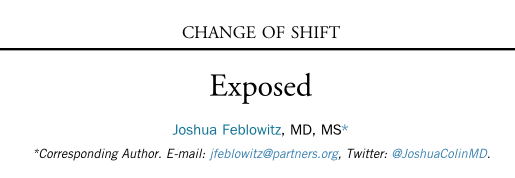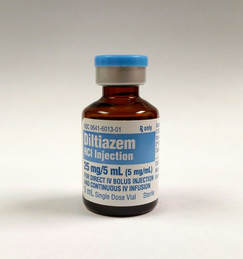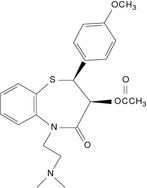|
When I was growing up, there were two things that I wanted to be more than anything: a doctor and a writer. Before I pursued medical training, my very first dream was to be a novelist. My childhood journals and old home computer were always littered with story ideas and the beginnings of novels. Even as I prepared for a career in medicine, I also maintained my love of storytelling and writing. I majored in American History & Literature while doing my pre-med classes, I pursued a journalism degree prior to going on to medical school and I started working as a freelance writer. When I began residency in Emergency Medicine in 2015, I knew that writing would have to take a backseat as I completed my clinical training, but it's also something I've missed a great deal over these past few years. That is why I’m so excited to share my new essay, "Exposed," which appears in the latest issue of Annals of Emergency Medicine. I’m grateful for the opportunity to join these two passions, to take an experience in medical training that was challenging and formative and share it with others in my specialty through creative writing. This essay centers on an experience that I hope will resonate with other healthcare providers: the dreaded needlestick injury. The piece examines the constant threat of the unknown that all clinicians come to know well, a fear that also helps keep us sharp and ready for anything that comes through the door. I attempt to capture how this anxiety and uncertainty mix with the thrill of discovery and capability during medical training. The lesson for me was that such an experience reveals an inherent truth of our field: the risks and rewards of medical practice are inextricably linked. You can read my essay, “Exposed” for free until September 7, 2018 here: https://www.sciencedirect.com/science/article/pii/S0196064418300763 Thanks for reading!
0 Comments
Recently, I took care of my first patient with a major calcium channel blocker (CCB) overdose. He was a middle aged man with unknown past medical history who had reportedly taken 20 tablets of diltiazem 120mg ER in a suicide attempt. Initial blood pressure in the field was 60/32, heart rate 30-40s. Knowing on an abstract level how sick these patients can get is one thing. Seeing it firsthand is something else entirely. Here are some lessons learned from a harrowing toxicological encounter.
Fortunately, this patient did well and ultimately did not need any 'end-of-the-line' therapies. This was a challenging yet valuable first brush with one of the sickest of all types of overdose patients. Like all difficult cases in the ED, teamwork and good communication were the bedrock of successfully managing the overdose.  Credit: Allan Ajifo Credit: Allan Ajifo As I near the halfway point of my third year as an emergency medicine resident, I've been inspired to shake the cobwebs and dust out of the right side of my brain and start writing again. In a previous life, I was a journalist and research writer, but after four long years of medical school and about two-thirds of my residency, that person started to feel a little foreign to me. After finally completing a long-term research project and experiencing the pride of seeing it in print, I began to long for the different but just as powerful feeling of crafting writing born of creativity and imagination rather than spreadsheets and statistics. Starting with the clinical training of my third year of medical school, I've had less and less time for these activities. But I promised myself when I started out at medical school that this part of me would not disappear, that even if it went into a period of hibernation, I would bring it back to light. Now I finally feel that a cloud has started to lift. As the scaffolding of emergency medicine becomes sturdier (though certainly not yet complete), there seems to be space for this other, equally important side of myself. The goals of this site will be severalfold and I'll attempt to outline them now to give myself a framework moving forward.
And with that, I'd like to re-inaugerate joshuacolin.com. For all of us, clinical practice is just one facet of our lives. I hope that this site will serve as a new outlet for me, to inspire creativity, learning and excellence in clinical practice in both myself and others. Thanks for visiting and enjoy! J |
AuthorJoshua Feblowitz, MD, MS, is currently a PGY4 resident in the BWH/MGH Harvard-Affiliated Emergency Medicine Residency (HAEMR) Program and a freelance science writer. Archives
March 2019
Categories
All
|


